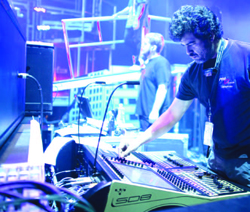
Steve Emler | Tesla’s “Forever More”
Steve Emler has been mixing Tesla for 15 years, and this summer, they’re supporting the Scorpions farewell tour as well as playing a mix of festivals, fairs and theatres.
Emler’s InnovaSon Sy48 digital console replaced a 700-pound Crest V12 and a double-wide 22-space outboard rack.
For effects he relies on InnovaSon’s FM-8VB plug-in effects module, which provides 8 mono or stereo quadeffects engines with algorithms from VB-Audio, including reverb, multi-tap delay and chorus.
He easily manages his numerous inputs with the console’s layer-less “SmartFAD” flexible VCA system for managing multiple inputs with minimal faders.
His first six faders are his SmartFader deployment area, with channel one starting on his seventh fader.
A fader can be assigned to control two or more inputs, spilling them into the SmaartFAD zone.
In this way, one fader controls both kick drum inputs, another both snares, a third all six toms and a fourth all four cymbal mics – like VCAs that replace a number of input faders.
Emler records every show on a rackmount PC with an EtherSound card by taking a split from his InnovaSon stage rack. He uses these tracks for a virtual soundcheck, and checks previous recordings on Tannoy nearfield monitors.
These recordings provided the material for Tesla’s recent “Alive in Europe” CD when the tracks were discovered to sound better than the leading multi-track recording solution they were using.
Bryan Farina | New York Voices
Bryan Farina has been mixing the New York Voices for three years, mostly on a Roland M-400 V-Mixer.
The vocal quartet has a performance style most often compared to Manhattan Transfer, with live performance formats varying from being backed by a trio, a big band, or a symphony orchestra for “pops” concerts.
Farina connects a pair of Roland S-1608 stage boxes to his V-Mixer’s two REAC inputs using Cat5 cable, and on symphony shows he frees up stage inputs by locating his wireless mics at the mix position and using the additional XLRs on the back of the console.
He often mixes floor monitors from out front by double assigning vocal inputs to a second set of channels. The console has a custom layer that allows assignment of inputs to faders in any order.
Farina adds that the new version of the firmware allows use of 8-band parametric EQ instead of 31-band graphics on the outputs. For effects on vocal, he enjoys the “Warm Hall” based on Roland’s SRV-2000 reverb unit.
He also uses a phasing effect for a Queen number performed in symphony shows. Farina adds that he’s looking forward to the new M-300 that will let him record WAV files to USB thumb drives and will be small enough to carry as excess baggage on his next European trip.
Robin Billinton | Barenaked Ladies’ “All in Good Time”
Barenaked Ladies played a mix of sheds and theatres this summer, followed by a UK trip in September, with Robin Billinton choosing a Soundcraft Vi6 console as his house console.
Though he wouldn’t have a problem using the Vi4, which is a foot shorter with 8 fewer faders, he says that most sound companies have opted for the larger console.
The Vi6’s right bank of 8 faders can be assigned to any 8 inputs, and Billinton fits the rest of the inputs on the first 24, while switching the right bank between keyboards and vocals.
He started using the Vi6 four years ago after trying other digital consoles and adds that “the Vi6’s ease of use is remarkable compared to other desks.”
For effects Billinton simply relies on the 8 Lexicon multi-effects in the DSP FX card in the Vi6 local rack, which he uses for his reverbs, delays and flanging effects and are easily edited on the Vistonics II screen.
The DSP FX card also provides BSS third-octave graphic EQs for every bus output, and they’re called up to the first 30 faders on the desk with the press of a button.
Steve Law | Keith Urban’s “Summer Lovin”
Steve Law has been with Keith Urban for 24 years, with this year’s “Summer Lovin” tour playing a number of festivals and fairs, plus supporting a few Eagles shows with the Dixie Chicks.
An early adopter, Law mixes Urban with a Studer Vista 5 SR digital mixing console, chosen for its sound quality, ease-of-use and reliability.
“The Vistonics user interface is the best in the industry,” Law states. “There’s nothing worse than hunting through a menu of operations while trying to keep up with the artist.”
“Instead, with the Vista 5 SR, it’s so good to have real knobs right beside each function, which makes the console more hands-on and more tactile,” he explains.
Building on the successes of previous Vista consoles in broadcast and install markets, the Vista 5 SR’s Vistonics control surface – instrumentation that combines screens and controls – is at a steeper angle to improve view-ability when standing in broad daylight.
The Vista SR Series also has more cooling fans, brighter LEDs and employs flash memory instead of hard disks. The Vista 5 SR is offered in a standard configuration of 84 mono and 20 stereo channels.
Mark Frink is Editorial Director of Live Sound International.
